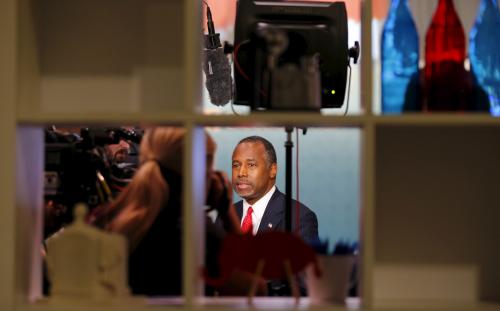Dr. Ben Carson goes before Congress this week as President-elect Donald Trump’s nominee for secretary of the U.S. Department of Housing and Urban Development. While Carson is not a priority target for Senate Democrats, he will still face tough questions on whether his decorated career as a neurosurgeon and public statements criticizing fair housing rules make him well-suited to lead the nation’s top housing agency.
Carson is an unconventional choice compared to his first-term predecessors. Henry Cisneros, who served under President Clinton, was a three-term mayor of San Antonio. Mel Martinez, who served under President George W. Bush, was a county executive and chairman of a housing authority in Florida. And Shaun Donovan, who served under President Obama, was housing commissioner for New York City Mayor Michael Bloomberg. Nevertheless, Carson would likely use his platform as HUD secretary to advance an agenda that reflects his unique life journey from urban poverty to self-sufficiency, taking the lead on Trump’s promise to “fix the inner cities.”
Given this likely emphasis, here are three issues that Carson will confront as HUD secretary as he forges a new federal approach to helping lift families out of poverty:
Improving high-poverty neighborhoods
Between 2000 and 2015, the number of people living below the poverty line rose 36 percent, from just under 34 million Americans to over 46 million, and the poverty rate increased by two percentage points. But where one lives matters. High-poverty neighborhoods, defined as places in which at least 20 percent of residents are poor, can lock families and children into a cycle of poverty because they lack good schools, nearby jobs, and are often fraught with high crime. Unfortunately, the number of high-poverty neighborhoods has more than doubled in the nation’s 100 largest metro areas, with the bulk of that growth occurring in the suburbs.
Any national effort to address poverty in place must acknowledge that distressed neighborhoods are now a regional phenomenon, and require comprehensive, multi-sector approaches that work for inner-city communities like those on the south side of Chicago as well as suburban neighborhoods like Ferguson, Missouri. Furthermore, Carson will need to speak to concerns that Trump’s Plan for Urban Renewal could repeat the mistakes of past top-down efforts to redevelop low-income neighborhoods.
Helping low-income families move to opportunity
Stanford professor Raj Chetty’s landmark analysis found that low-income children whose families moved to better neighborhoods experienced greater earnings gains over time, validating residential mobility as an important strategy for fighting multi-generational poverty. Conservatives, as outlined in Paul Ryan’s Better Way plan, have embraced this approach, calling for greater portability of housing vouchers as key to expanding opportunity. Indeed, as my colleagues Elizabeth Kneebone and Natalie Holmes have found, households with housing vouchers live in lower-poverty neighborhoods than their counterparts in public housing. However, most voucher holders in the largest metro areas still live in relatively poor neighborhoods: the typical voucher holder lives in a neighborhood with a poverty rate of 24 percent. To ensure mobility results in true choice and access to opportunity-rich neighborhoods, Carson will also need to focus on how HUD can ensure success in portability through increased supply of affordable housing in good neighborhoods, housing counseling assistance for families, and tools for local governments, employers, and other key partners to promote community acceptance of diverse housing options.
Promoting pathways to jobs with affordable housing
Whether low-income families stay in their existing neighborhoods or move to better ones, HUD policies can support pathways to employment and better wages, as was seen in the Jobs-Plus program. At the same time, high-quality affordable housing itself is critical for helping families and children succeed in the labor market and classroom. As Matt Desmond’s powerful book Evicted demonstrates, frequent moves can exact a devastating toll on vulnerable households. Carson himself may have had firsthand experience with this sort of housing instability. Furthermore, being employed does not immediately mean that families can afford decent homes in the private rental market. As wages fail to keep pace with housing costs in many high-cost, job-rich areas, low-income and working families need affordable housing and housing assistance as they work their way up the job ladder. Carson should keep the foundational role of affordable housing in mind amid some calls to mandate work or time-limit assistance in housing programs.
Carson has offered few clues into his views on housing policy, save for his 2015 opinion piece on fair housing and recent public remarks at his alma mater, Yale University, where he debunked notions that he plans to gut public assistance programs. This week’s hearing will provide important and welcome insights into how Dr. Carson will steer an agency often overlooked but critical to expanding opportunities in cities and suburbs for low-income and working families.





Commentary
Three opportunities for Ben Carson as the next HUD Secretary
January 11, 2017